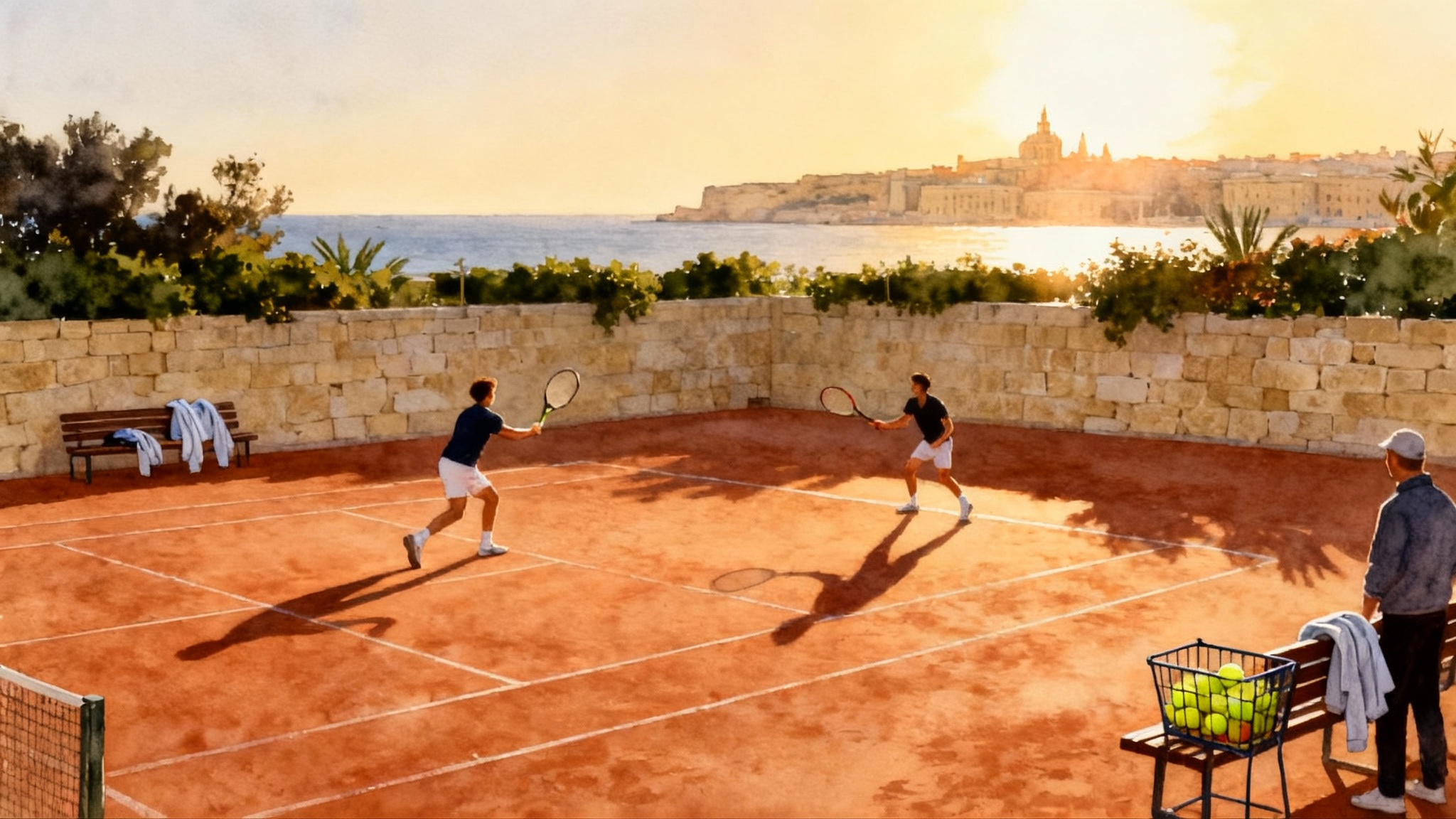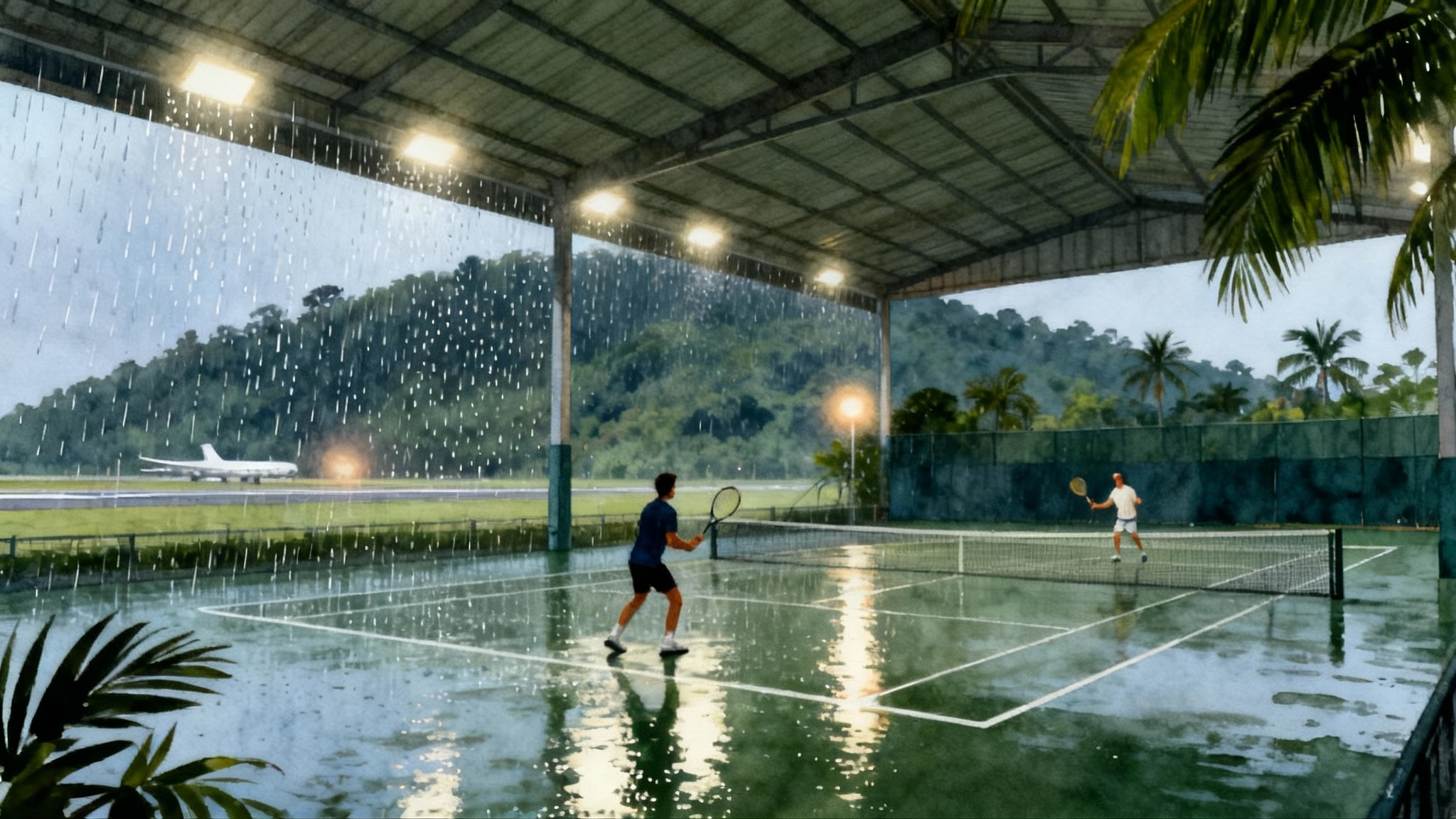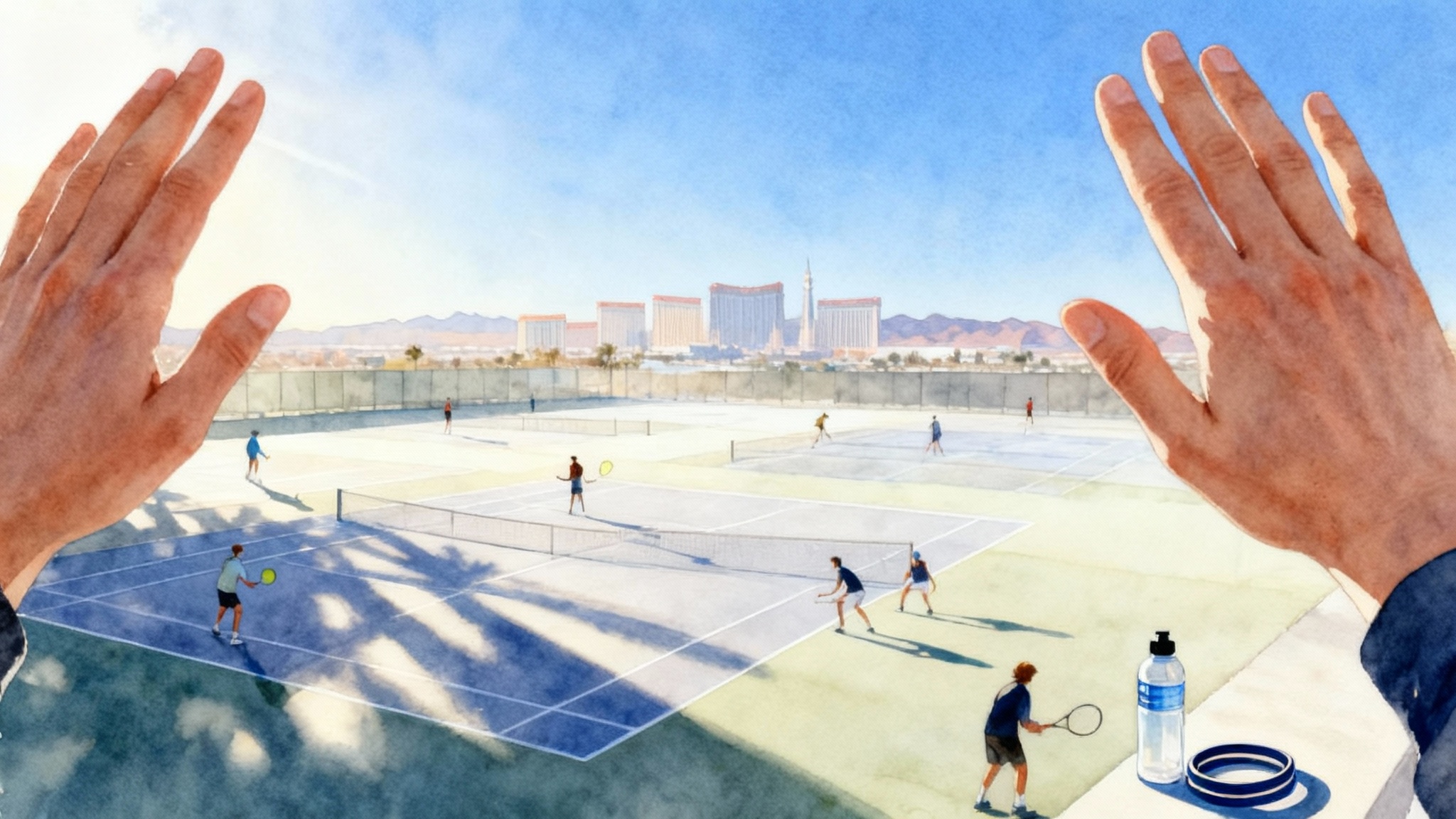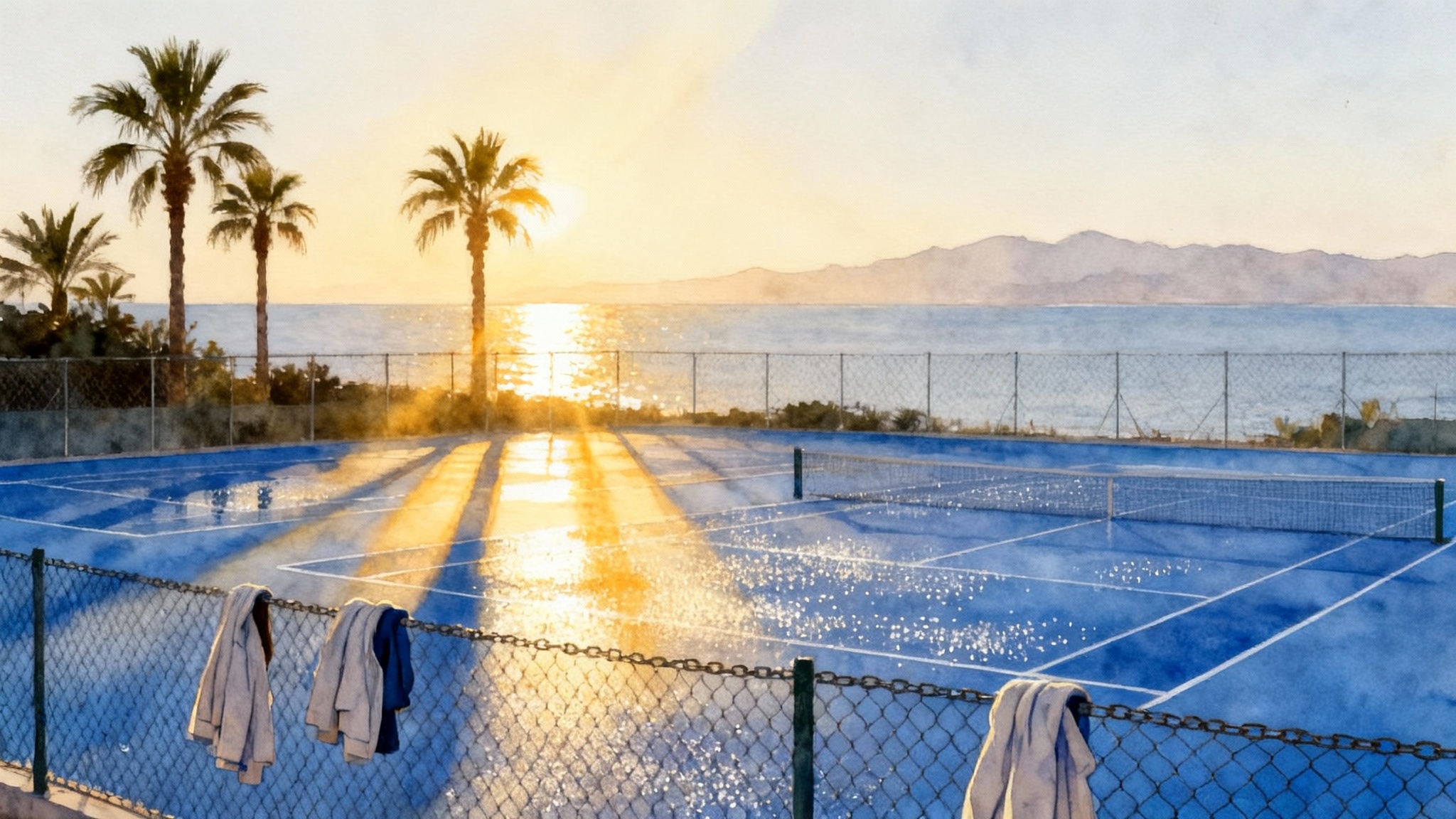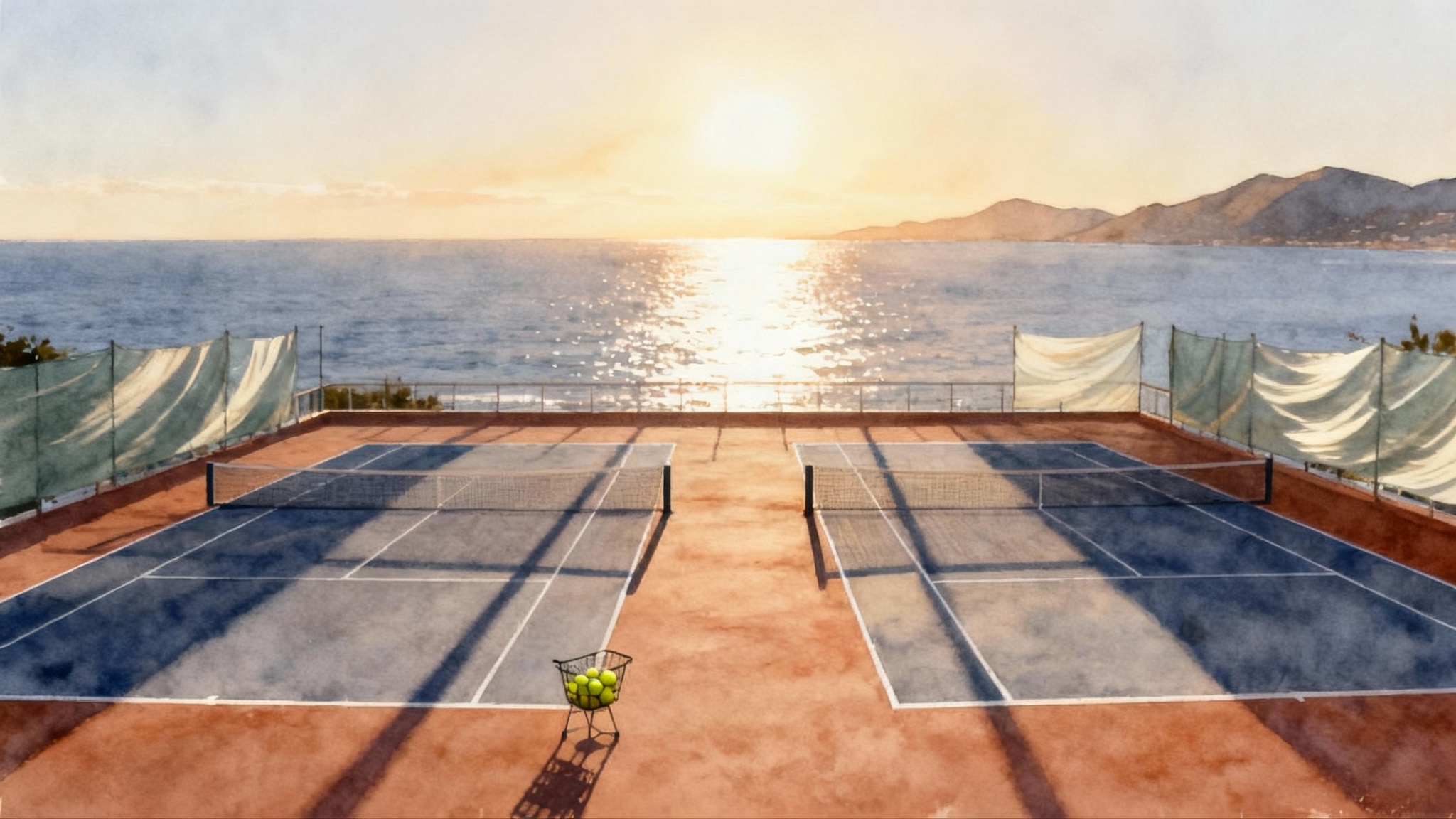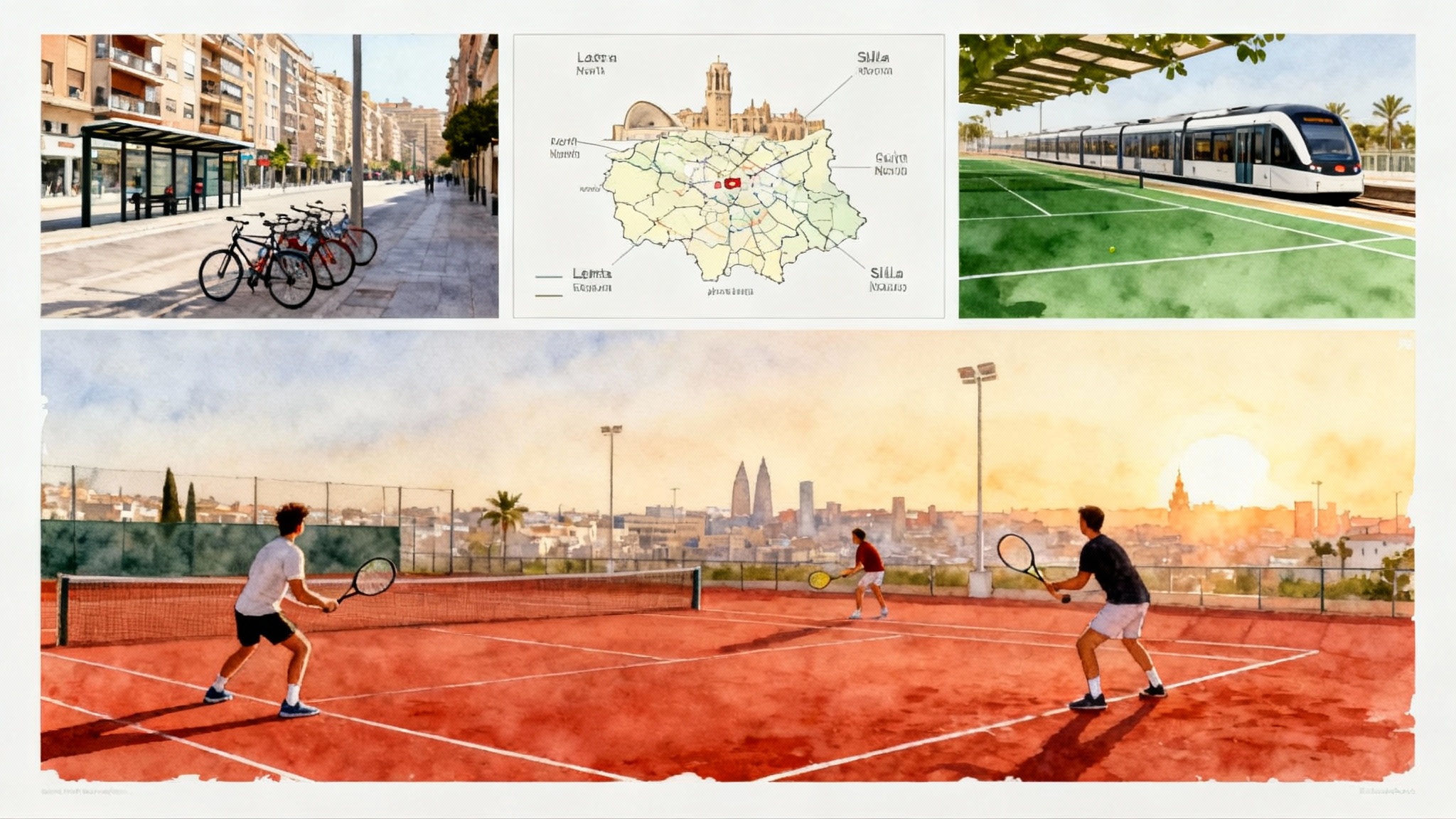Algarve Shoulder Season Tennis: Vilamoura Training Guide
Plan a climate-smart 7 to 14 day tennis block in Portugal’s Algarve. Use Vilamoura Tennis & Padel Academy as your base, with sample microcycles, surface mixing, walkable stays, recovery runs, local match play, and a 2025–26 Algarve vs Costa del Sol comparison.
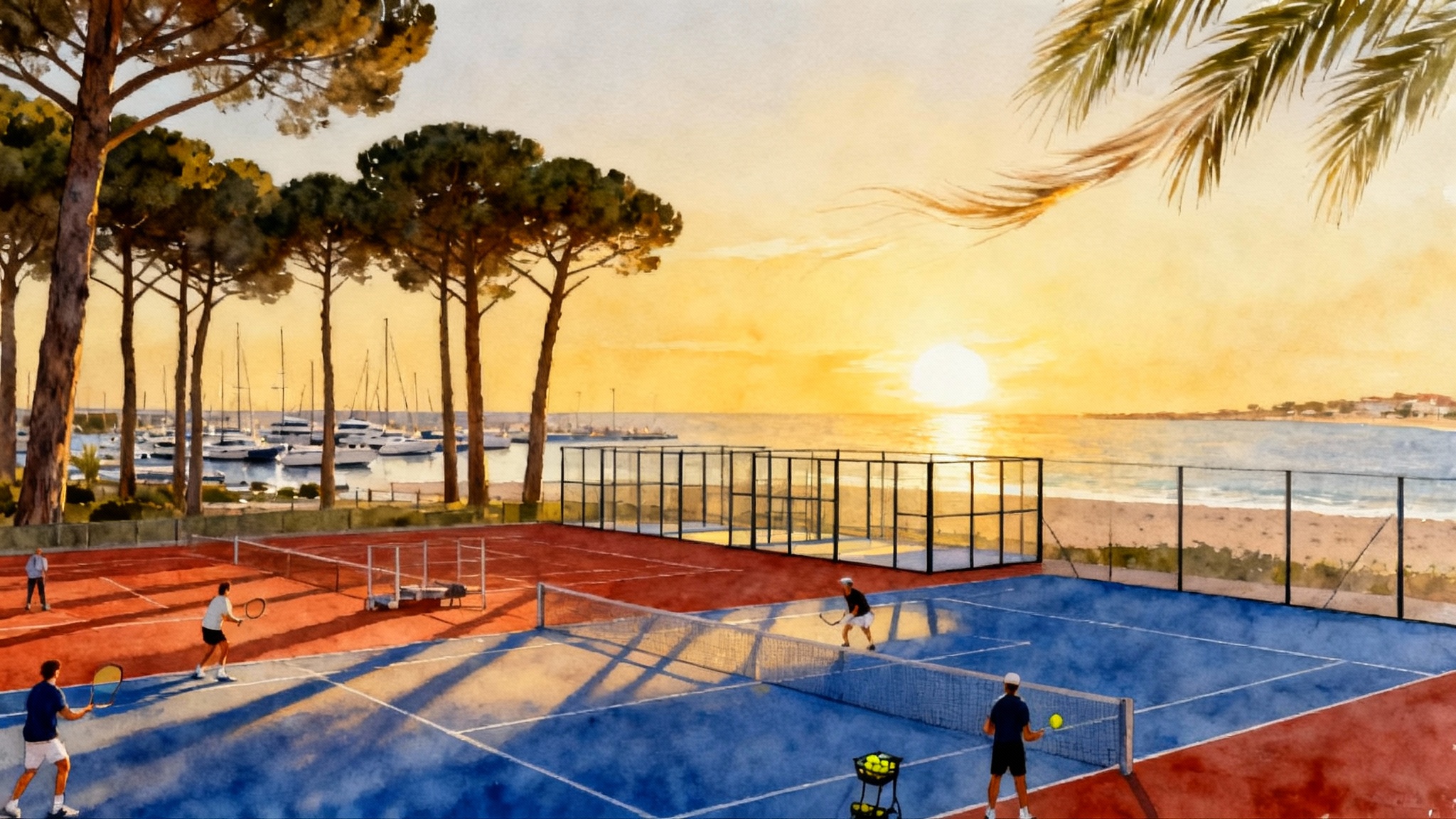
Why Vilamoura in the shoulder season
If you want European sunshine without the scrum, spring and fall in Portugal’s Algarve are a sweet spot. Vilamoura is built for walking, with a marina at the heart of things and pine-lined neighborhoods that feel calm even when nearby beaches are lively. The Vilamoura Tennis and Padel Academy sits close to the marina, so you can finish drills and stroll to a coffee, rather than lose time in traffic. Courts are easier to book, coaches have space to focus, and the weather is cooperative enough to stack quality sessions without battling mid-summer extremes.
Think of shoulder season as playing the advantage in a long deuce game. You still get the light and warmth that help balls jump off the strings, but you are not spending your changeovers hiding from scorching heat. That combination lets you build volume, refine patterns, and recover well.
When to go and what the weather really feels like
For a 7 to 14 day block, target mid March to early June, or mid September to early November. Mornings are cool, afternoons are warm, and nights are comfortable for sleep. The Algarve has an Atlantic influence, which means breezes that keep sessions fresh and a smaller chance of stagnant, sticky heat. According to the Portuguese national meteorological service’s reference data for Faro, the climate normals in these windows show mild temperatures with relatively low rainfall compared with winter, as outlined in the IPMA climate normals 1991–2020.
What that means on court:
- Spring: light jacket on the walk over, short sleeves by the time your heart rate rises. New balls feel lively mid-afternoon.
- Fall: sea water is still pleasant after September, so a short recovery swim is realistic. Sunset is early enough that evening lights sessions are useful for serve rhythm under floodlights.
- Wind: plan a few cross-court rally drills that teach you to aim through breeze. Treat it like resistance training for your ball trajectory. If a day turns gusty, shift to footwork ladders, serve targets, and approach-volley patterns where precision matters more than pace.
Design your 7 day tune-up
This one-week template fits a player returning to competition or a traveler using vacation time to sharpen habits. Adjust volumes up or down based on your baseline fitness.
Day 1: arrival and assessment
- Morning or early afternoon arrival. Walk the academy to learn the court map and talk to the desk about stringing turnaround.
- Short mobility, band work, twenty minutes of shadow swings and serves. Keep the first day low load.
Day 2: foundations and patterns
- Morning: ninety minutes on clay for length and height control. Cross-court rally ladders at seventy to eighty percent intensity. Ten minute serve window to end.
- Afternoon: thirty minutes of footwork and sprint mechanics on the track or promenade. Finish with calves and hips mobility.
Day 3: change of pace on hard
- Morning: ninety minutes on hard court for timing against a quicker bounce. Two focused blocks: backhand cross to down-the-line change, then inside-out forehand plus recover. Add eight minutes of second-serve patterns.
- Optional evening: sixty minutes of padel doubles for aerobic volume without extra pounding. Keep rallying rather than blasting winners.
Day 4: light day and recovery
- Morning: sixty minutes of serves and returns, half pace. Add overheads and approach volleys. Cut it short if you feel heavy.
- Recovery: beach walk in ankle-deep water for gentle calf flushing.
Day 5: test set play
- Morning: match simulation on your preferred surface. One set starting at two all, repeat. Work changeovers like a real match.
- Afternoon: video review on a phone or tablet. Identify one tactical change for tomorrow.
Day 6: competition day
- Morning: full best-of-three practice match or two timed sets. Warm up like a tournament. Capture serve stats and return depth.
- Evening: light stretch and early bed.
Day 7: deload and travel or extra day
- Mobility circuit, fifteen minute jog on the promenade, strides, and a short swim if seas are calm. Pack dry gear and snack for the trip.
Scale it to 14 days with a microcycle
For two weeks, use a build, unload, build, taper pattern. The goal is stimulus, adaptation, then sharper stimulus.
- Days 1 to 3 build: two court sessions daily, one technical, one situational. Alternate clay and hard to spread load. Keep padel to one session across the first three days.
- Day 4 unload: one light technical hour plus mobility. Massage or physiotherapy if needed.
- Days 5 to 7 sharpen: include two match-play windows with a lefty or an aggressive net rusher if those opponents trouble you.
- Day 8 recovery: beach walk, stretch, pool work. No hitting unless you crave touch volleys.
- Days 9 to 11 intensify: heavier patterns session plus live points, then a doubles session to build returns and first volleys under pressure.
- Day 12 light skills and serves only.
- Days 13 to 14 taper and test: one full match on day 13, then short feel session and departure or event on day 14.
Mechanics that make this work
- Split heavy lower-body days with clay in the morning and padel or mobility later, so joints get a break from repeated hard-court decelerations.
- Keep serve loads predictable. If your shoulder is sensitive, cap total serves at one hundred a day split into two windows.
- Track sleep hours and simple readiness markers like resting heart rate. If your resting heart rate jumps by more than five beats per minute and you feel flat, swap a hard session for a technique hour.
Surfaces: mix clay and hard, add padel for volume
Vilamoura offers both clay and hard, and padel is widespread. Use clay for length, defense, and balance under slower bounce. Use hard for contact point discipline and first-strike play. Padel adds social, lower-impact rallying that drives footwork and hand skills without the same lateral stress as singles tennis on hard.
A simple rotation
- Monday clay: cross-court ladders and high, heavy patterns.
- Tuesday hard: serve plus one and return depth.
- Wednesday padel: sixty to ninety minutes, focus on control and court position.
- Thursday clay: approach, drop shot, and transition.
- Friday hard: points from serve and return, short format.
If you play doubles, borrow padel’s geometry. Work lobs, overhead transitions, and wall-like patience at the net. The tactical patience from padel often carries back to tennis volleys.
Where to stay within a walk
Vilamoura is compact. You can build a car-free week if you choose accommodation with an easy route to the academy and to the marina for meals.
- Budget self-catering: apartments in the Old Village area or near central Quarteira put you within a fifteen to twenty minute walk. Look for units with a small kitchen, a balcony for drying kit, and quiet bedrooms away from late-night bars.
- Mid-range hotels: Dom Pedro Vilamoura and Vila Galé Ampalius are known marina-area choices within a comfortable walk of the courts and the beach. Ask for rooms on lower floors if you prefer stairs over lifts. Many guests use these as base camps for active weeks.
- Upscale stays: Tivoli Marina Vilamoura sits on the harbor with easy access to the promenade and shops. If you want resort pools for recovery and a little spa time, this is the convenient pick. For golf-adjacent villas, Four Seasons Vilamoura near the Pinhal course gives a quieter base with kitchenettes, but confirm the walking time to the academy.
Booking tip: choose refundable rates in case you want to shift days after looking at the ten day forecast. In shoulder season those flexible options are often affordable.
Recovery that feels like holiday
You can recover without leaving town.
- Beach run route: jog from the marina along the boardwalk toward Quarteira. It is mostly flat. Build a session with ten minutes easy, six by one minute faster with one minute easy, then ten minutes cool down.
- Sand strides: on the hard-packed sand near the waterline, do six short accelerations at fifty to sixty percent effort. Focus on posture and relaxed shoulders.
- Sea soak: five to eight minutes in the water reduces ankle and calf soreness. Ease in slowly, watch flag warnings, and never swim alone.
- Mobility: pine-shaded lawns near the courts work for twenty minutes of hips and thoracic spine rotation. Bring a travel mat or use a towel.
- Food: the marina has quick options that work for athletes. Look for grilled fish, boiled potatoes, olive oil, and salad. A bowl of rice and roasted chicken travels well if you have a mini fridge.
Find match play and friendly competition
The academy desk is your first stop for arranging sets with locals or other visitors. Give them your Universal Tennis Rating, which is an international scale from one to sixteen that estimates playing level, or describe your match experience if you have no rating. Ask about:
- Weekly mix-ins and social doubles. These are reliable for an hour of new ball tolerance and returns under different spins.
- Hitting partners. Some coaches or advanced juniors are available for rhythm sessions at stable pace if you want repetitions without match stress.
- Padel ladders. Even if tennis is your focus, one or two ladders help you meet people and keep your overall training volume high without extra knee load.
If you like to organize independently, search for local leagues and booking apps that are popular around the Algarve. Padel players in Portugal often use Playtomic, which makes it easy to join hosted games or reserve courts. For tennis, ask the academy whether they list spare booking slots on an app or handle everything by phone.
Algarve vs Costa del Sol in 2025–26: weather and value
Both coasts are proven spring and fall training grounds, and both have direct air access from across Europe. For a different European shoulder-season base with mild conditions, compare our Grasse–Valbonne microclimate guide. If you prefer a larger Iberian city with clay depth, see the Valencia Tennis 2025–26 guide.
Weather reliability
- The Algarve has an Atlantic touch. It runs breezier and a shade cooler in spring and fall than the western Mediterranean. That can be good for long rallies and day-after-day volume.
- The Costa del Sol around Málaga trends a little warmer and drier in shoulder months. Spain’s meteorological service lists normals for Málaga Airport that show warm daily means in April, May, September, and October compared with winter and early spring in the AEMET Málaga airport normals. Plan sun protection and hydration accordingly.
Value and logistics
- Court access: both regions offer public and private booking. In Vilamoura, shoulder season typically means easier blocks on the same court at the same time each day, which is ideal for routines. In busier Costa del Sol towns, you may end up stitching together different venues if you book late.
- Lodging: Algarve apartment inventory near the marina gives strong value if you cook breakfast and simple dinners. In the Costa del Sol, choice is broad, but proximity to courts can be trickier in dense beachfront towns where the best prices sit farther inland.
- Car-free setup: Vilamoura makes it simple to go without a rental car for a week. In the Costa del Sol, distances between your accommodation, courts, and beach may be larger, which can push you toward a car unless you choose a resort with on-site courts.
Training implication
- If you want consistent routines and minimal logistics, Vilamoura is hard to beat. If your priority is heat acclimation and dry conditions for serve velocity and high bounce, Málaga and its neighbors can deliver that extra temperature bump.
Practical logistics for a smooth block
- Flights: fly into Faro for Vilamoura. From the airport, a rideshare or taxi reaches the marina area in about thirty to forty minutes depending on traffic. If you are traveling from the United States, connect through Lisbon, Madrid, or a northern European hub.
- Getting around: choose accommodation that makes the academy and a supermarket walkable. Bring a foldable daypack for groceries and a reusable bottle.
- Court bookings: email the academy at least two weeks ahead with your preferred times and surfaces. Ask about floodlights, ball machines, and stringing. Confirm if clay courts need brushing by players between sessions so you account for transition time.
- Equipment: bring two frames and a backup set of strings. If you usually play in a very dry climate, add a slightly higher tension option for humid evenings.
- Health and safety: the sun is real even on cooler days. Use a broad-spectrum sunscreen and a hat. Pack a light long-sleeve for morning warm-ups. Build a hydration routine with electrolytes for afternoon sessions.
A simple, sustainable packing and prep list
- Two pairs of shoes: one for clay, one for hard. You do not want to mix clay dust onto hard courts.
- Eight to ten pairs of socks and quick-dry kit so you avoid daily laundry runs.
- Reusable bottle and small cooler bag for courtside fruit and yogurt.
- Resistance bands, a jump rope, and a lacrosse ball for mobility.
- A compact first aid kit with blister care and tape.
- Earplugs and a sleep mask. Good sleep is the cheapest performance enhancer you can buy.
Sample daily menus that fit training
- Breakfast: oats with yogurt, banana, and nuts. Coffee, then five hundred milliliters of water.
- Pre-court snack: small sandwich or a handful of dates and a yogurt drink.
- Lunch: grilled fish, rice, and salad. Add olive oil and a piece of fruit.
- Afternoon snack: smoothie or an orange and a protein-rich yogurt.
- Dinner: chicken and potatoes with vegetables, or a pasta with tomato, olive oil, and parmesan. Keep it familiar so your stomach is happy on court.
The academy as your hub
The local academy near the marina offers both clay and hard courts, plus padel, and typically runs coaching, social sessions, and equipment support. Ask about package pricing for repeated bookings, and whether they offer weekly match-play mixers. Many players like to start the week with one assessed lesson to set drills and technical themes, then layer in self-led sessions and a couple of match windows.
If you are traveling with a partner or a small group, consider booking two side-by-side courts for the biggest days. You can run cross-traffic drills or rotate in threes without slowing momentum.
A final word
Great training blocks have a rhythm. In Vilamoura in spring or fall, that rhythm feels natural. You wake to a quiet walk through pines, the first serves lift cleanly in cool air, the rallies stretch without punishing heat, and the marina is close enough for a simple lunch before an afternoon session. You are building capacity without drama. Give yourself two weeks in that groove and you will head home with more than a good tan line. You will have a game that travels and the confidence that comes from work done right.
